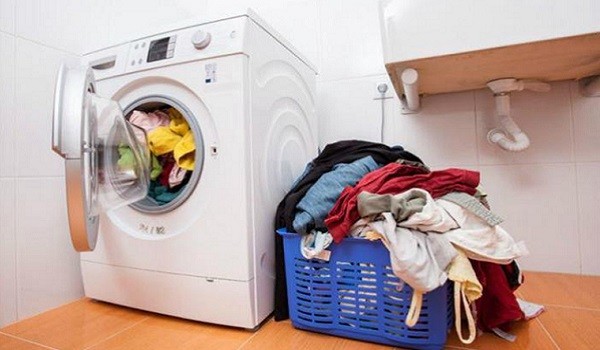It is a common habit to wash all the clothes and underwear of the entire family together, but this is not a good idea. In reality, the bacteria that live and cling to each person’s body are usually distinct, and mixing them in the wash can quickly lead to cross-contamination and infections, putting family members at risk of illness.

It is recommended to wash clothes and underwear separately. If you wish to wash a mix of clothes, use a washing machine with disinfectant and antibacterial properties. After washing, it is important to dry and sterilize the clothes.
Not inspecting clothes before putting them in the washing machine
Failing to inspect clothes before washing can lead to some troubles. For example, if there is a tissue in the pocket, it will disintegrate and leave bits of paper stuck to the clothes, making them look dirty and unpresentable.
If clothes are heavily soiled with mud, for instance, putting them in the wash without first removing the mud will cause it to dislodge, mix with the water, and stick to other clothes. Moreover, excessive soil can build up in the washing drum, leading to blockages and reducing the lifespan of the machine.
Therefore, it is important to thoroughly check clothes before putting them in the washing machine to ensure there are no foreign objects in the pockets. If there are metal fasteners, it is best to fasten them before washing to prevent them from damaging the inner drum during the wash cycle.
Putting worn clothes directly into the washing machine
Some people have a habit of putting their clothes directly into the washing machine after wearing them. However, the washing machine may not be able to remove all stubborn stains or discolouration. Therefore, before washing, it is advisable to soak the clothes in water, hand-wash them, or use a specialized detergent to treat stains, ensuring a more effective and thorough cleaning process.
Additionally, you can use safe alternatives to bleach, such as lemon juice, baking soda, and vinegar. Lemon juice is an excellent and affordable natural cleaner that can remove old stains, while baking soda can eliminate discolouration.
Choosing the quick-wash setting
To save time, many people opt for the quickest wash setting. However, a simple quick-wash cycle typically only includes washing, rinsing, and spinning, skipping some essential steps that ensure thorough cleaning.
The quick-wash setting is suitable for thin clothes in the summer or when the garments are not heavily soiled. If you have a large load of laundry, it is recommended to use the standard wash cycle and add one or two extra rinses.
Not hanging clothes to dry immediately after washing
If washed clothes are not hung to dry immediately, they remain damp and lack ventilation, creating an ideal environment for bacteria and mould to thrive. Prolonged dampness encourages rapid mould growth, resulting in unpleasant odours and fabric damage, such as discolouration and flaking.

Furthermore, hanging clothes in a poorly lit or ventilated area can be detrimental. Sunlight helps kill bacteria and mould, keeping clothes clean and dry, while fresh air prevents dampness and inhibits the growth of bacteria and mould.
Using too much detergent or fabric softener
Some people believe that using more detergent or fabric softener will make their clothes cleaner and smell better. However, this is a common mistake that can lead to faster deterioration of clothing.
In reality, using excessive detergent can clog the detergent compartment and cause unpleasant odours. Additionally, too much fabric softener can hinder the cleaning process. It is advisable to use the recommended amounts and, if necessary, utilize measuring tools for accuracy.
Not cleaning the washing machine
Over time, dirt, detergent residue, and other grime can build up inside the washing machine and transfer to your clothes, causing discolouration and unpleasant odours. To address this issue, consider the following:
Clean the machine after each use.
Remove any residual detergent from the door and drum after each wash.
Regularly clean the detergent drawer.
Disinfect the machine monthly using vinegar, alcohol, or plain water.






































